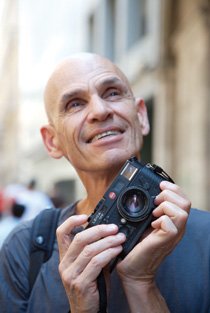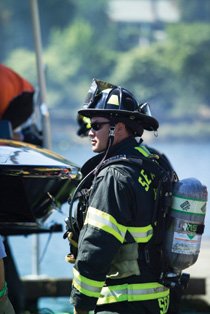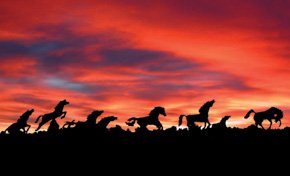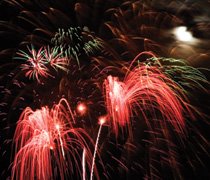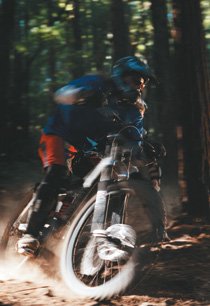Creative Techniques
| Your new dSLR most likely came with various shooting modes designed to make it easy for you to shoot different subjects with optimal settings. But the optimal settings don't always translate into the most compelling images. In this section, I take a look at some of the various modes and explain why you might want to override those settings. In the process, you learn more about exposure options, allowing you to move away from the shooting modes when you're ready to take your photography to a new level of control. PortraitsBy default, Portrait mode gives you a minimum depth of field to blur out backgrounds like the one shown in Figure 4.17. Depending on the type of portrait you want to capture, a blurred background might be just the opposite of what you want. Figure 4.17. The typical image captured in Portrait mode has a minimal depth of field, which is often the correct setting.
It's getting more and more popular to take environmental portraits, where the subject is in a familiar setting that shows them in their element. In this example, you'd want more depth of field in order to show that environment with the subject. For this type of portrait, you need to switch to Aperture Priority. In Figure 4.18 you can see the result of shooting in Aperture Priority with a setting of f/8 on a telephoto lens. Figure 4.18. When you want to include some of the surroundings in the image, switching from Portrait mode to Aperture Priority is the way to go.
The subject and immediate surroundings are in sharp focus, and the distant background is still blurred, giving you the best of both worlds. LandscapesThis mode is the opposite of Portrait mode, giving you the maximum possible depth of field while still keeping the shutter speed high enough to handhold the camera. In low-light situations, which are usually the best for landscape, such as sunrise and sunset, this means less depth of field than you want for a landscape image. Once again, it's Aperture Priority to the rescue. Note You'll have better results using a tripod whenever possible. There's a common rule in photography that says you shouldn't try to handhold your camera for any exposure longer than the focal length of your lens (roughly). In other words, if you're using a 50mm lens, you shouldn't handhold anything slower than 1/60 second. As an example, the image shown in Figure 4.19 would have been nearly impossible to capture using Landscape mode, so I used Aperture Priority along with a tripod for a 1/4-second exposure. Figure 4.19. In low-light situations, Landscape mode may not work for you. In this case, I used Aperture Priority along with a tripod to get a longer exposure.
Night PhotographyOne of the advantages of a dSLR is that you can take longer exposures than you can with a digicam. Although many dSLRs include a Night mode, it's often not a very long exposure (although it is long enough that you'll need a tripod), seldom more than one second. By switching to Manual mode, you can use the bulb setting. Bulb is a holdover term from the old days when a shutter release was triggered by using a blast of air through a handheld bulb. Today, bulb means the shutter stays open as long as the shutter button is pressed. Most cameras have an optional cable release or remote shutter release that can be used for this purpose, letting you take photos that can be as long as your batteries last. As an example, Figure 4.20 shows a 16-minute exposure used to capture star trails. By pointing the camera at the north star and leaving the shutter open for long periods of time, you can capture the movement of the stars across the sky. Figure 4.20. Star trails take longer to capture than Night mode can deal with. In this case, it's time to switch to Manual mode and use a cable release for a one hour or more exposure.
For more down-to-earth night photography, capturing images of fireworks is a popular subject, and once again bulb mode is the proper choice. For the examples shown in Figures 4.21 and 4.22, I used exposures of 6 seconds and 8 seconds at f/22 to record multiple bursts of fireworks along with their trails. Figure 4.21. A six-second exposure lets me capture multiple bursts of fireworks.
Figure 4.22. Don't be afraid to experiment. Here I've used a eight-second exposure to photograph more bursts with longer trails.
Macro and Close-up PhotographyIn macro or close-up photography, you normally want the most depth of field possible. Because the working distances are so short, even an aperture of f/16 doesn't give you much depth of field. But, as with the other examples, you don't always want the typical setting. There are times when a more artistic look is desired. For example, Figure 4.23 shows what type of image macro mode can give you at a small aperture of f/16. Figure 4.23. This is a typical macro mode photo, with maximum depth of field.
In the next example, Figure 4.24, I've used a wider aperture to reduce the depth of field. By changing to f/8, only the ends of the stamen are in focus, giving me a nice soft background. Figure 4.24. By moving to Aperture Priority, I reduced the depth of field to give me a more artistic look.
Sports PhotographyAfter all the previous examples, you may be wondering why your camera even has a Shutter Priority mode. When you shoot in Shutter Priority mode (sometimes called Sports mode), you're optimizing the exposure for a fast shutter speed to let you freeze action, as Figure 4.25 shows. Figure 4.25. Sports mode optimizes the shutter speed to freeze action.Photo by Laurence Chen
But static images where all action is stopped isn't always the best choice for showing action. By switching to Shutter Priority and choosing a slower shutter speed, you can capture the motion in the scene, giving your photo a feeling of life and activity like the one shown in Figure 4.26. Figure 4.26. Switching to Shutter Priority and slowing the exposure down lets you capture motion in your sports shots.
|
EAN: 2147483647
Pages: 91
